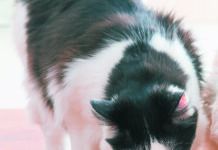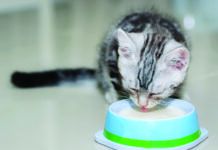Regardless of how distinctive their individual personalities may be, all cats have in common the need for a nutritious daily diet. Although the most readily available sources can be found on the shelves of virtually any food market or pet supply shop, many owners are convinced that their cats will benefit most from meals that are prepared at home.
THINKSTOCK


Before embarking on such a project, however, these owners need to be forewarned, explains Cailin Heinze, VMD, assistant professor of nutrition in the Department of Clinical Sciences at the Cummings School. Preparing and feeding a proper homemade diet is bound to be time-consuming, could be expensive, and — unless based on a full awareness of feline nutritional needs — might ultimately compromise a cat’s overall health. She strongly warns against preparing homemade meals without discussing the topic with a veterinarian and requesting a referral to consult with a board-certified veterinary nutritionist.
Cat food must be balanced
Whether the food is prepared in the owner’s kitchen or comes in a can or bag purchased at a supermarket, it must contain a wide and properly balanced array of essential nutrients, says Dr. Heinze. These fundamental nutrients include proteins that are derived from an animal source, such as chicken, fish or beef; a variety of important fatty acids; and dozens of life-sustaining vitamins and minerals. A prolonged deficiency of any of these dietary components can potentially have grave consequences.
A deficiency of vitamin A, for example, can cause certain eye disorders, muscle weakness, reproductive failure and other serious health problems. (On the other hand, an excess of this vitamin can cause disorders including abnormal bone development and fatal birth defects.) To the list of potential nutritional deficiencies Dr. Heinze adds: calcium deficiency, which can cause bone fractures; and thiamine deficiency, which can cause seizures and coma.
Also, she notes, a deficiency of an amino acid called taurine may lead to a variety of feline health problems, including dilated cardiomyopathy, a serious heart disorder. (Fortunately, this problem rarely occurs these days among domestic cats that eat balanced commercial diets, since the manufacturers of these foods supplement their products with adequate amounts of taurine.)
Cat owners who might mistrust commercial cat food, she notes, should know that over the past half-century, the American pet food industry has made significant progress in providing nutritionally sound, affordable and easily available canned and dry products. The contents of these foods are based on nutritional requirements that are published every year by the Association of American Feed Control Officials (AAFCO).
In order to be labeled “complete and balanced,” all commercial cat foods must comply with the standards published by AAFCO, either by meeting a nutrient profile or by passing a feeding trial. Monitoring compliance with these standards is carried out by feed control officials at the state level.
“Most veterinarians,” says Dr. Heinze, “would credit modern commercial diets with improving overall feline health and contributing to the longer life spans enjoyed by today’s pet cats. Fortunately, it’s very rare these days that you have to treat a cat that doesn’t do well on one of the available commercial foods.”
Owner preference
Despite the pet food industry’s general willingness to see to it that their products comply with existing nutritional standards, some owners — perhaps a growing number of them — still prefer to prepare cat food in their own kitchens, and they do so for a variety of reasons. Some, for example, may feel that home cooking will save money. Or they may have become convinced that commercial food is apt to be tainted with foul ingredients and dangerous preservatives.
Others may be disinclined to feed their cats anything that is not “organic.” (Unfortunately, as this term is not defined by AAFCO, no guidelines exist for its use as it applies to pet foods.) And some owners, Dr. Heinze points out, simply want to have control over the foods that their cats routinely consume.
In general, says Dr. Heinze, “There are no known nutritional advantages of a home-cooked food for a normal, healthy cat, although it’s possible that a cat with specific health disorders might do better with homemade meals than with commercial food. For example, a cat with kidney disease might also be allergic to chicken. Since almost all commercially available therapeutic diets for kidney disorders contain chicken, it makes sense that, in such a case, home cooking may be better. You’d be able to keep the nutrients at their proper levels for the kidney problem without introducing an ingredient that the cat cannot tolerate. But this kind of condition is very, very rare. In the vast majority of cats, there is no known nutritional benefit to home cooking.”
As for the cost, she points out, “Preparing a balanced homemade diet is not simply a matter of using the leftover food that you have on hand or buying whatever is cheap at the grocery store. The supplements alone that your cat is likely to need for a well-balanced diet are going to cost quite a bit. In the long run, commercial food is going to be cheaper than a balanced home-cooked diet in just about all situations.”
Veterinary support is vital
Owners who are determined to go forward with home-cooked meals, Dr. Heinze advises, should be very careful about the source of their recipes. “There have been many studies that have looked at recipes that are available in books and on the Internet,” she notes. “These studies have shown that the vast majority of these recipes are deficient in essential nutrients.”
Apart from various foods — such as onions, chocolate and raisins — which can seriously sicken a cat, Dr. Heinze points out, there are no specific ingredients that must be avoided in a home-prepared meal. But more important than the individual dietary constituents is the way in which the ingredients are balanced for an individual cat. In that regard, she urges owners who want to home-cook to obtain their recipes from a board-certified veterinary nutritionist.
“We recommend,” she says, “that an owner who is determined, for whatever reason, to feed a homemade diet should have the cat undergo a physical examination, including bloodwork, at the outset and every six months because the risk of nutrient deficiencies is higher than it is with commercial foods. And we also recommend that the diet recipe itself be reevaluated once a year because a cat’s dietary requirements are apt to change as time goes by, and also because published nutrient guidelines change as new research data are published.”
Also, she notes, the nutritional makeup of some dietary constituents — fatty acid levels or the amount of micronutrients, for example — may increase or decrease over time due to changes in the way that the ingredients are produced or grown.
Importance of bloodwork
Whether a home-cooked diet is meeting the nutritional needs of a specific cat can be difficult to assess, says Dr. Heinze. “The problem is that most nutrient deficiencies take weeks to months, sometimes even years, to show up,” she points out.
“Unfortunately, the first sign that you have a problem may be catastrophic. The consequences depend on which nutrient is lacking. A calcium deficiency in an adult cat, for example, may take a year or two before it becomes evident, a taurine deficiency may take a few months, and a thiamine deficiency can potentially show up within a few weeks,” explains Dr. Heinze.
“So that’s why we recommend a thorough physical exam and bloodwork twice a year and an annual diet reassessment for any cat that is eating a homemade diet. This will provide some degree of assurance that any potential problems will be spotted early enough to be easily remedied.”



